Go read five startup home pages. Most sound like someone gave ChatGPT a word limit and a thesaurus.
“We help teams unlock scalable solutions.”
Okay. But what do you actually do?
Writing a great value proposition isn’t supposed to be a branding riddle. It’s a sentence that tells someone what your product or service actually does, who it’s for, and what they’ll walk away with without needing to scroll back and re-read.
This blog breaks it down properly: How to write a value proposition, what to include, what to leave out, and how to avoid sounding like everyone else.
What is a value proposition?
A value proposition is a short, clear explanation of what your product or service does, who it’s for, and why someone should care. It tells your target audience what they’ll gain and how your solution makes their life easier, better, faster, or at least less annoying.
It usually covers three things: the pain points your ideal customer is dealing with, the outcome they’re hoping for, and how your offer delivers that outcome better than other options. An effective value proposition makes that connection in one or two sentences, max.
If someone sees your value proposition statement and instantly understands what you offer and who it’s meant for, you’re on the right track. That’s what we’re aiming for, and we’ll break down how to write a compelling value proposition. But first…
Core elements of a compelling value proposition?
Not every value proposition makes people stop and think, "This is exactly what I need." The ones that work focus on solving a clear problem for a specific target audience and explain the result without making you guess.
If your value proposition statement feels confusing, flat, or like it could belong to any business, it’s probably missing something important.
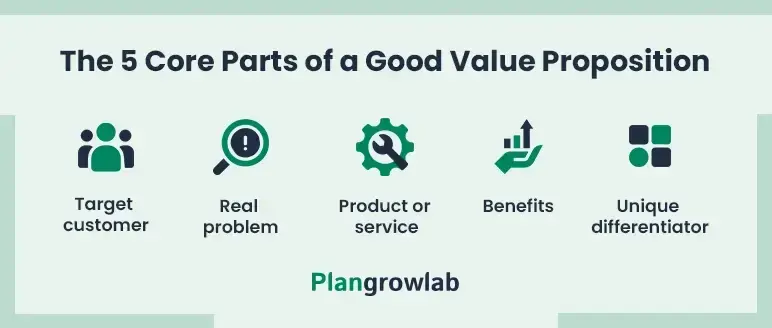
Here’s what you need to get right if you want people to understand your brand offering.
1. A clear target customer
Customer focus starts with understanding the target audience for which your product or service is built. That means knowing what they’re trying to fix, what they’ve already tried, and what they expect from a better option.
When you define your target market, you’re identifying someone with clear pain points, a reason to act, and a basic expectation for how your offer helps.
2. A real problem (Customer pain points)
Your value proposition should reflect a pain point your target customers already know exists. It could be late shipments, clunky onboarding, low conversion rates, or the time it takes to train new team members.
If you’re not sure what the problem is, start with market research. Look at support tickets, sales objections, reviews of competing products, or even Reddit threads in your space.
3. The product or service you're offering
After naming your product or service, focus on the specific benefits it delivers. Your target audience wants to know what will improve or what they’ll gain by using it.
Can it save time, reduce errors, or improve customer experience? Be direct. Clear, measurable outcomes make for a more effective value proposition than vague claims.
4. Clear benefits or results
Your value proposition should make it clear what your product or service helps people achieve. Focus on specific benefits they can act on, things that impact their workflow, output, or daily efficiency.
Say what changes. Will they finish tasks faster? Eliminate duplicate steps? Reduce the number of tools they use? Use actual numbers or examples when possible.
5. Why you’re not just another option
Your unique value proposition shows what makes your product or service different. It could be faster onboarding, better support for sales teams, or solving a part of the process most competitors ignore.
Pull this from real feedback or customer jobs that others miss. Use a value proposition canvas or proposition template to turn that into a clear sentence. If it’s specific and easy to spot, it gives your value prop a clear edge.
How to create a unique value proposition for your business (w/ examples)
You don’t need a background in copywriting to write a clear, useful value proposition. You just need to know your customers, your product or service, and what actually improves when people use it.
Here’s a 5-step process of how to create a value proposition.

Step 1: Pick the clearest customer problem you solve
The first step to writing a good value proposition is simple: start where your customer profile is already frustrated. If you could magically fix one daily hassle for them, what would it be?
Calendly didn’t invent meetings. It just fixed the endless email chains that happened when two people tried to set one up. Their value prop focused directly on saving hours of back-and-forth.
You can find your version of this by using your value proposition canvas, looking at real feedback, and watching what people complain about across social media accounts. Are they chasing refunds? Wasting time on manual data entry? Missing deadlines because of confusing handoffs?
Track buying behaviors, too. When something costs customers time, energy, or momentum, they look for solutions and fast.
Once your value prop hooks into a real everyday problem, your brand promise doesn't feel like marketing anymore. It feels like common sense. That's how your proposition stands out without shouting. A succinct value proposition always starts with real people, real struggles, and a clear hint that better days are possible.
Step 2: Connect your solution to a clear outcome
Start with what changes in your customer’s life when they start using your solution. Does it shorten the process? Cut down on tool-switching? Save their marketing teams from spending three hours building reports no one reads? Whatever the benefit, it needs to be specific and believable.
Notion didn’t market itself as “the best workspace.” It said: “All your work, in one place.” That tied directly to what people were frustrated with: using five apps to do one job. That’s a real shift with less chaos, fewer tabs, and better project management.
Use your value map to link your core proposition with a measurable result. Then match it to your customer profile. This helps tighten your positioning statement and keep your marketing efforts focused on what people actually care about.
When your solution maps to clear customer gains, fits your business strategy, and reflects an acceptable value at a relative price, it becomes more than a pitch. It becomes a brand promise that actually lands.
Step 3: Describe your unique advantage in simple words
You already know what problem you solve. Now, you have to show why your product or service is the smarter pick. That’s where your proposition canvas helps you spot what’s missing in your competitors’ business strategy or find customer jobs they overlook.
Pick one real advantage. It could be that your tool needs no setup. It could be that you bundle all the tools people usually have to manage separately.
Most platforms compete on a scope. Basecamp didn’t. They built their brand proposition around doing less, intentionally. It worked because customers were asking for something that just worked without drowning them in features.
Your goal is to get to one clean value map idea:
- What makes you easier, faster, or more reliable?
- Where do you offer acceptable value at a better relative price?
- How do you connect better to real potential customers?
Use a proposition template or value proposition canvas if you need help organizing it, but keep it tight.
A succinct value proposition beats a bloated list every time. If you lead with one proposition-focused idea that solves real customer pains, your brand proposition wins.
Step 4: Draft an effective value proposition that’s short, sharp, and specific
Now, it’s time to actually write a value proposition. One that sounds like a real person wrote it, not something that belongs in a forgotten mission statement.
The goal is to come up with one or two lines that pull together the clearest pieces you’ve already mapped out—target customers, the main customer jobs, your product or service, the key customer gains, and your unique edge.
Here’s a value proposition example:
"For independent tutors who lose track of student payments, PayTrack is a billing tool that automates reminders, logs history, and gets you paid without chasing."
Why it works:
- Target customers (independent tutors)
- The problem (losing track of payments)
- The company’s product (a billing tool)
- Specific benefits (automated reminders, logged history, less manual follow-up)
If you need help shaping it, try a value proposition template or go back to your proposition canvas. The classic proposition formula works:
“For [the audience], [product] solves [problem] by [benefit].”
Keep it sharp. And if you’re tempted to throw in words like “accelerate” or “empower” to sound impressive, don’t! That’s how you avoid the common mistake where a proposition fails, not because the product isn’t good, but because the message didn’t land.
As Emma Stratton, author of Make It Punchy, puts it:
“'Accelerate' has no place in messaging. You’re selling B2B tech, not Formula 1 or a Fast & Furious movie.”
She once titled a pitch deck “Accelerate-o-rama 💨” to show how overused that word had become. The point is that generic language doesn’t make you sound smart, it just makes your message forgettable.
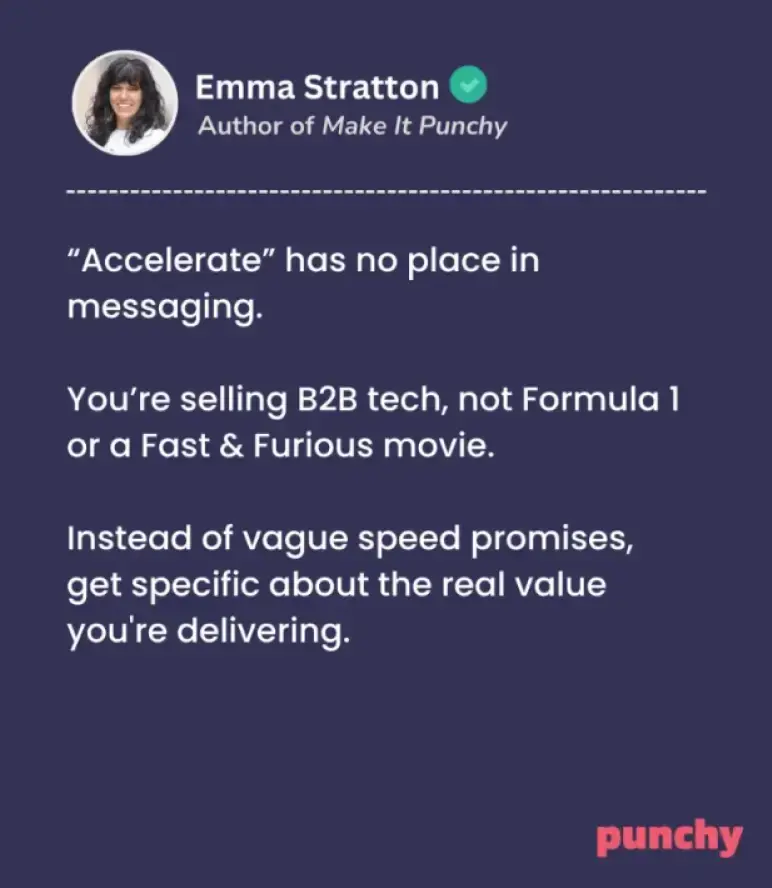
A good value prop is clear, specific, and believable. It should sound obvious.
Step 5: Pressure-test it. Would a stranger get it instantly?
Start by showing your draft to someone who’s not on your team. Even better, ask a few people from your target audience. Don’t explain it. Just ask them what they think it means.
If they can repeat the key message back in one line, you’re on track. If they hesitate or respond with “Wait, what do you actually do?”—go back and clean it up.
Use the exact words your audience would use. The best value prop doesn’t try to sound smart. It just sounds right.
If you’re still not sure which version works better, test them. Drop two options on a landing page or run a quick A/B test. See which gets more clicks or signups. That’s how you figure out which one actually convinces customers.
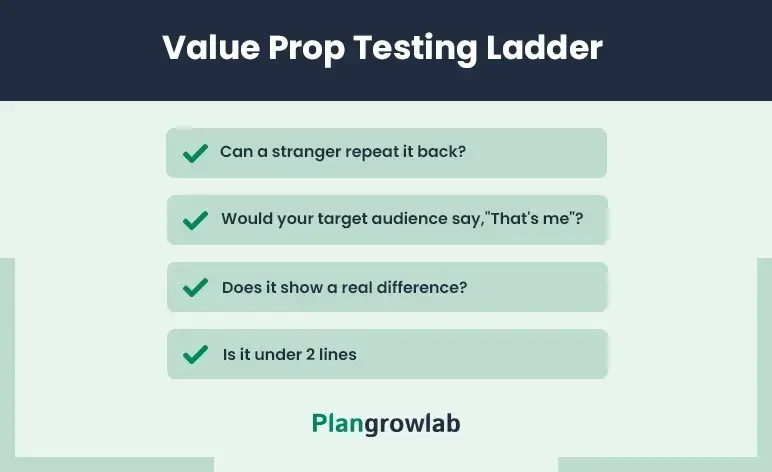
A great value proposition doesn’t need defending. It either lands or it doesn’t. Keep refining until it hits. And if you’re still stuck, a free value proposition template or a well-built value proposition canvas can help you compare what works and what doesn’t.
Value proposition vs mission statement vs tagline: breaking down the differences
A lot of businesses blur the line between a value proposition, a mission statement, and a tagline. Before you move forward, let's separate them so the right message gets to the right people.
Value proposition: What you offer, who it’s for, and why it’s worth it. It’s the real workhorse that convinces potential customers to care. Think of one concise statement built to drive action, not admiration.
Mission statement: Why does your company exist at all? It’s about your bigger goals and values, not the everyday buying behaviors you're trying to influence.
Tagline: A catchphrase. It is short, catchy, and looks great on a billboard. (“Just Do It” is a tagline, not a value prop.)
Confusing them messes with your brand clarity and makes your value proposition sound like another boring slogan. Keep each one in its lane.
Formula to create a solid value proposition
You’ve got your research, your value proposition canvas, and a general idea of what to say. Now, you just need a structure that helps you write a version that’s clean, fast, and clear.
Use this basic formula:
[For X audience] who [face Y problem], [brand] provides [Z solution].
(Optional: Add a short outcome at the end if it makes the benefit even sharper.)
Or this stripped-down version:
[Problem] + [Solution] + [Outcome]
Here are a few value proposition examples using the format:
- For busy HR teams who struggle to keep track of employee onboarding, Onboardly provides an automated checklist and progress tracker so nothing slips through the cracks.
- Freelancers, struggling to manage too many tools? We combine project management, billing, and scheduling in one app so freelancers can work without chaos.
- For restaurant owners who are losing time on manual reservations, TableTrack replaces spreadsheets with a smart booking system that prevents double bookings and no-shows.
Use this as a base. Then, refine your own value proposition with the right language for your target audience. You don’t need to be clever, just accurate.
If your value prop checks all the boxes—real customer problem, clear benefit, actual differentiation—you’ve already got the bones of a successful value proposition.
Practical tips to create a strong value proposition
Before you call your draft “done,” run it through these checks.
1) Use the words your customers actually say
Start by borrowing the words your customers already use. This means reading customer reviews, support chats, interviews, or survey feedback, not marketing copy. When you pull wording directly from your target audience, your message feels like it came from inside their head.
It also sharpens your message fast. If your customers describe their problems in plain terms like “I waste time chasing invoices,” your value prop should mirror that. Customers notice when you're speaking their language that instead of delivering a pitch, they have to decode.
2) Focus on one outcome, not a feature list
The most effective value proposition centers around one core outcome, not a laundry list of product features. When your message tries to say everything, it usually ends up saying nothing specific. Choose the single biggest result your product or service delivers and lead with that.
This also gives your audience a takeaway they’ll remember. Think about what they’ll walk away with after reading the statement. Is it time saved? Money protected? A task removed from their plate? Anchor your value prop on that one gain and let the rest support it quietly elsewhere.
That’s the one outcome your proposition emphasizes and what your audience will remember.
3) Be specific, especially with numbers
A value prop with actual numbers builds more trust than one filled with generic claims. If you can say “cut costs by 30%” instead of “save money,” do it. Specifics make your outcome feel achievable, and that motivates your potential customers to pay attention. When you're not able to include a stat, use exact, grounded words instead, like “save hours” or “send invoices in two clicks.”
Back the number with a simple explanation if needed, or link it to real use cases. This builds credibility and makes your value proposition measurable, something you can later support in sales conversations, case studies, or landing pages.
4) Say what makes you different (Clearly)
Your value proposition should make it obvious why someone should pick you over alternatives. That clarity is what your proposition helps differentiate from the rest.
Is it a unique feature, a speed advantage, or a competitive pricing model that others just can’t offer? This is about showing what sets you apart in a way your target customers can instantly recognize and understand
Review your proposition canvas and note what competitors often miss or underplay. Then, bake that difference into your value prop. It doesn’t have to be loud, just clear. If a competitor can say the same sentence without changing a word, yours isn’t distinct enough yet.
5) Match the tone to your brand
How you write a value proposition should reflect how your business talks across all channels. If your tone is casual and people-first, keep the message friendly. If your business is detail-heavy and professional, let your value proposition reflect that clarity and structure.
Matching tone also helps keep your messaging flexible. Whether you're placing the value prop on a homepage or pitching it live, it should sound like the same company speaking. When tone and content align, your well-crafted value proposition builds faster trust and makes your positioning easier to remember.
6) Add a real emotional benefit (If it fits)
Every business offers outcomes, but many also offer feelings: peace of mind, confidence, and relief. If your product or service brings those emotional customer gains, include them alongside the main result. It helps readers connect on a level beyond pure logic, and that's often what gets someone to act.
You don’t need to overdo it or get poetic. Just think: What does your user feel once the problem is solved? “Save 5 hours a week” becomes stronger when it leads to “so you finally stop working weekends.” Pairing emotional benefits with clear results creates a more complete value proposition.
7) Test it where it’ll be used
Your value proposition isn’t finished until you test it in context. Drop it into your website, your pitch deck, or your lead-generation email.
Say it out loud in a meeting. Does it hold up? Does it sound natural? That simple test tells you more than any template.
Watch how people react. Do they nod, or do they squint? If your message gets ignored or misinterpreted, rework it until the result feels obvious. The best value props don’t just look good in a doc. They convert, get remembered, and lead directly into the next conversation.
Real-world examples of strong value propositions
Writing a value proposition gets easier once you’ve seen a few good ones. Here’s a quick breakdown of real examples worth learning from.
1) Slack
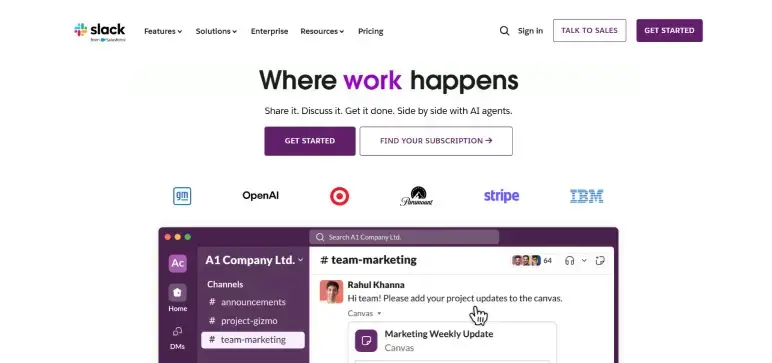
“Where work happens. Share it. Discuss it. Get it done. Side by side with AI agents.”
Slack positions itself as the digital workspace where all kinds of work happen—conversation, collaboration, and now AI-driven tasks, too. This value proposition focuses less on features and more on the role Slack plays in a modern work setup.
2) Shopify

“Sell online and in person. Sell locally and globally. Sell direct and wholesale. Sell on desktop and mobile.”
Shopify is positioning itself as the central hub for all your selling—storefronts, pop-ups, retail counters, you name it. Their value prop is about unifying it all into one reliable platform, which makes life easier for business owners juggling multiple formats.
3) Birdeye

“Get found online, improve your reputation, and manage your social presence across locations with AI.”
Birdeye instantly communicates who it’s for (multi-location brands), what it does (manage reputation and social presence), and how (with AI). That one-liner is clear, bold, and immediately filters in the right potential customers.
4) Help Scout
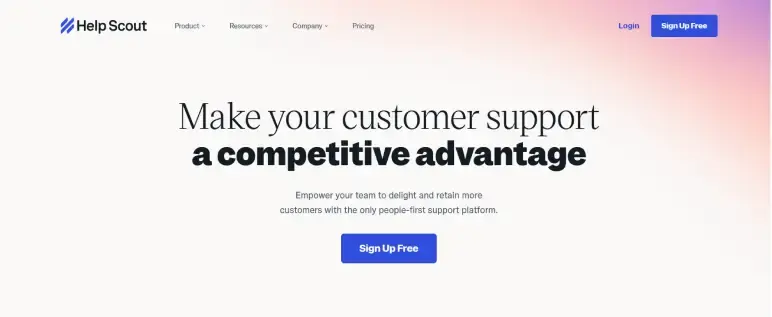
“Empower your team to delight and retain more customers with the only people-first support platform.”
Help Scout positions support as more than just a service function. It’s something that can drive growth. That flips a common pain point (support being reactive or frustrating) into a strategic asset.
5) Canva

“Canva makes it easy to create and share professional designs.”
It grabs attention with a short, memorable headline that reflects their brand personality — accessible, creative, and friendly. But the real value prop lives in the sentence that follows. Canva’s actual promise is simplicity and professional output, and they spell that out clearly.
When you write a value proposition for your business, don’t copy these.
Learn from them, and then make sure your own value proposition feels like it belongs to your brand, not anyone else’s.
🚨 Notice this: What all effective customer value propositions have in common
When you look at the examples above, they all have the same moves:
- Clear target: You know exactly who they’re talking to.
- Real problem: They focus on an actual issue people care about solving.
- Simple solution: They say what they offer in everyday words.
- Specific outcome: They hint at real customer gains, not vague promises.
If your own value proposition checks these boxes, you’re not just "good.” You’re already better than 90% of what’s out there.
Conclusion
A value proposition is your first real shot at making someone care about what you offer. It gives potential customers a reason to stick around. When done right, it tells them exactly who you help, how, and why they should pay attention, all in one short, specific line.
If you’ve gone through the steps, you already have a clear value prop. Ask someone who’s never heard of your business if it makes sense. Because when it does, everything gets easier—your website, your pitches, your marketing.
And if you’d rather have expert eyes on it, PlanGrowLab can help. From sharpening your messaging to writing your business plan, we’ll help you make your value proposition do what it’s supposed to do: earn attention and build trust.
Frequently Asked Questions
How long should a value proposition be?
Keep it short. One to two lines max. If you can't explain the core value in under 15 seconds, it's too complicated. Use a simple value proposition template if you’re stuck.
Should I create multiple value propositions for different audiences?
Yes, if you serve different target customers with different customer jobs, you might need a few value prop variations. One size rarely fits all. Focus on each one based on who you’re talking to.
What’s the difference between a value proposition and a tagline?
A value proposition explains what you do, who it’s for, and what real outcome you deliver. A tagline is a quick brand slogan. If you're trying to write a value proposition, stay functional, not catchy.
How do I know if my value proposition is working?
Pressure-test it. Show it to a few people who don’t know your business. If they get it instantly and can repeat it back in their own words, you’re on the right track. If they look confused or need an explanation, it’s time to edit.
Can a value proposition change over time?
Yes. As your business strategy evolves or you find a better product-market fit, your own value proposition should evolve, too. It's normal to revisit it once a year or after major changes (new markets, new offers, new pricing).
Is it okay to use emotional words in a value proposition?
Yes, but carefully. Emotional touches can make a good value proposition even stronger as long as the concrete outcome is still clear.

